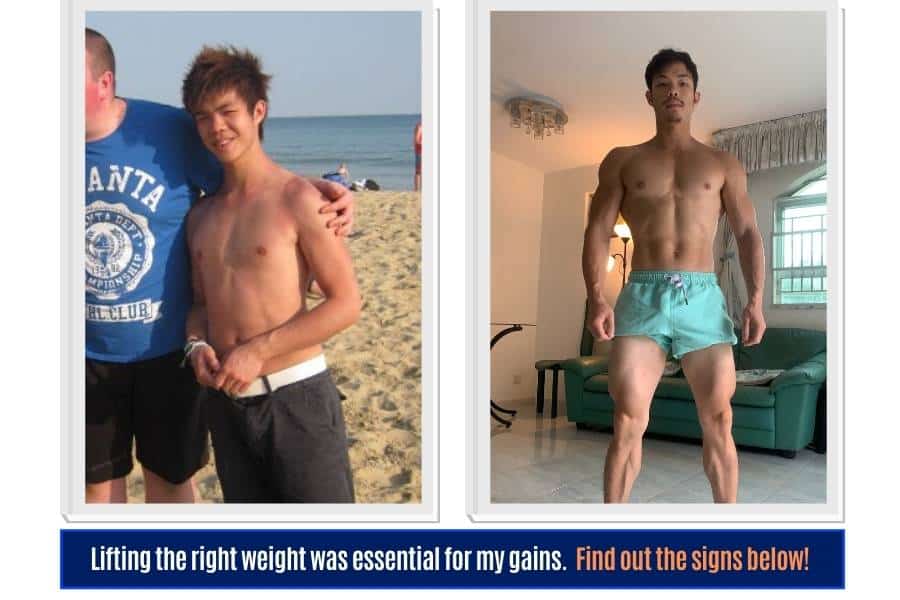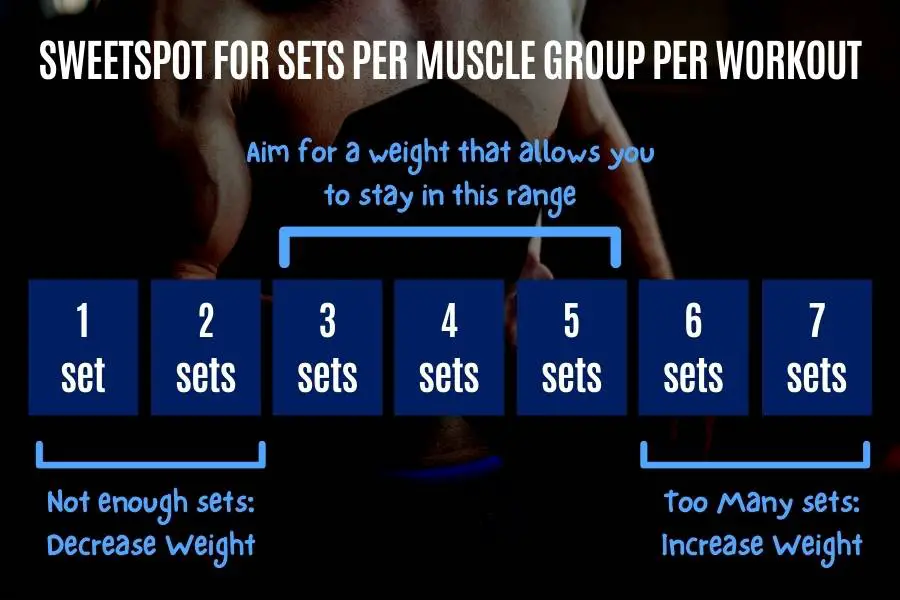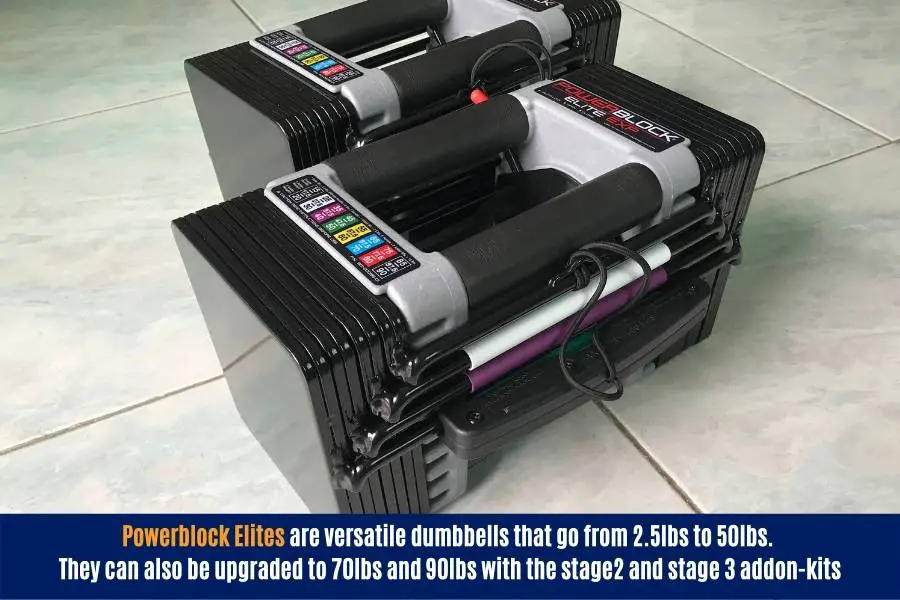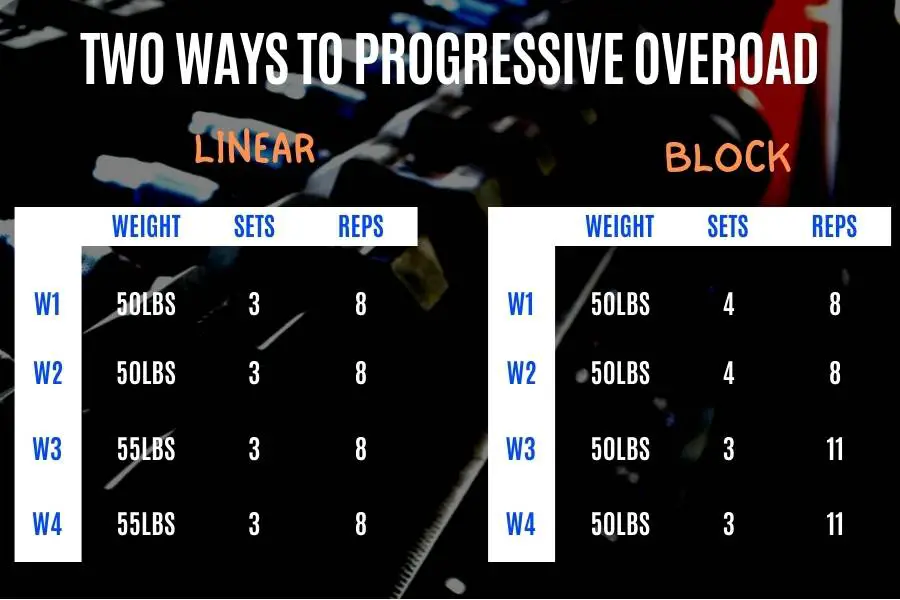To maximize your returns on weight training investment, you must use the correct weight. If your weights are too heavy, you sacrifice form, muscle activation, and even risk injury. In contrast, weights that are too light will lead to fruitless results. This post shares 9 signs that you are lifting too much weight and 9 signs you are not lifting enough weight.
Common signs that a person is lifting too much weight are the inability to complete repetitions, form breakdown, and excessive fatigue. Common signs that a person is not lifting enough weight are if the workout does not feel challenging and the absence of progressive overload.
Below, I’ll go into more detail as to what exactly this means.
The signs that I share are based on my personal 10-year weight training experience and research from personal trainers and coaches.
They will help you to find just the right weight to effectively reach your training goals!
Let’s get stuck in.

9 Signs You Are Lifting Too Much Weight
Here are 9 signs that you’re lifting too heavy.
If you observe more than a few of these signs in your training, then you should consider decreasing the weight on your dumbbells, barbells, or kettlebells.
1) Failure To Complete All Reps In A Set
The ideal number of repetitions per set varies depending on your training goal:
| Training Goal | Recommended Reps | Recommended Sets | Recommended Rest |
|---|---|---|---|
| Increase strength | 4 to 6 reps per set | 3 to 5 | 4 to 5 mins per set |
| Build muscle and tone | 8 to 15 reps per set | 3 to 5 | 1 to 3 mins per set |
| HIIT and cardio | 8 to 25 reps per set | 4 to 5 | 30 to 60 seconds per set |
If you’re unable to complete all the designated reps within a set (specific to your training goal), then you may be lifting too much weight.
2) Form Breaks Down In The Last 3 Reps
Lifting form describes your ability to complete a specific exercise with the correct technique to maximize the activation of the target muscle.
Examples of bad form practices include:
- Using hip momentum to help generate upward force to help lift dumbbells in a bicep curl.
- Jerking the dumbbells upward at the top of a dumbbell row.
- Swinging the dumbbells up and down during the dumbbell bench press or fly.
If you have to resort to the examples above to help you lift your barbells/dumbbells/kettlebells, then this is a big sign that your weights are too heavy
You should consider lowering your weight.
Concentrate on slow, meaningful, and controlled, movements instead.
3) Injuries Are Common
Is your weight training causing injuries?
Examples of injuries related to weight training include (but are not limited to):
- Persistent joint pain even when not working out.
- Sharp joint pain during a lifting exercise.
- Pulled muscles.
- Torn muscles.
- Slipped discs.
- Back pain.
If any of these are a common occurrence, then this is another big sign that you are lifting too much weight (lower the weight on those dumbbells for the sake of your safety!).
Injuries could also be caused by other reasons like improper form, technique, and overtraining (but these are often directly related to using too heavy a weight).
4) Using The Same Weight On Isolation And Compound Lifts
Isolation lifts are small exercises that move around a single joint, usually activating single muscle groups.
In contrast, compound moves are big exercises that move around multiple joints and activate multiple muscle groups.
Here are some examples of isolation and compound lifts:
| Isolation Lift Examples | Compound Lift Examples |
|---|---|
| Dumbbell curl | Bench press |
| Tricep extension | Dumbbell floor press |
| Lateral raise | Shoulder press |
| Dumbbell/kettlebell chest fly | Rows |
| Dumbbell/kettlebell reverse fly | Pull-ups |
| Leg extension | Squats |
| Hamstring curl | Deadlift |
Since isolation lifts are inherently much smaller movements, they also require ~40% less weight compared to compound moves.
So if you’re using poundages on your isolation lifts that are similar to your compound moves, then this is a big sign that you’re lifting too much weight on the isolation movement (or too little weight on the compound movement).
Solution?
Adjust the weight accordingly!
5) The Weight Is Unstable During The Lift
A certain degree of weight instability is normal during a lift, especially with dumbbells and kettlebells (these are inherently less stable than barbells).
Beginners will also find that weight instability is more pronounced compared to more experienced lifters.
But if you find that the weight is moving uncontrollably left, right, and center, then this is one of the biggest signs that the weights you are lifting are too heavy.
Solution?
Lower the weight on those dumbbells or barbells!
Regardless of your training level- the weight should be unstable enough to challenge the muscle but not so unstable that the weight cannot be controlled along its path of movement.
There’s a fine line between the two. And this line is easier to distinguish with practice.
6) You Can’t Complete More Than 2 Sets In A Workout

Did you know there’s an ideal number of sets you should do per workout for maximum muscle and strength gains?
It lies somewhere between 3-5 sets per muscle group per workout, which allows you to complete 10-15 sets per muscle group per week (depending on how many training days you dedicate to the given muscle group).
A telltale sign that your weight is too heavy is if you struggle to complete more than 2 sets per workout for that given exercise.
Using a dumbbell bench press as an example:
If, after your second set, you fail to complete all the specified reps for the third set, then you know that your dumbbells are too heavy.
Solution?
Lower the weight to hit that 3-5 set sweet spot!
7) Unable To Overcome Sticking Points
A sticking point describes the position in a lift where the effort required to complete the lift suddenly becomes extremely difficult.
Now, this 2016 study has suggested that experiencing a sticking point in the last rep in a set can be greatly beneficial for athletic improvement (since the muscles are being challenged appropriately).
But if you’re experiencing a sticking point before you’ve even reached the last rep, and you’re unable to complete the lift, then you know you’re likely lifting weights that are too heavy.
Using a dumbbell curl as an example:
If you’re aiming to complete 12 reps for bicep growth, reach a sticking point on the 8th rep, and are unable to overcome the sticking point, then you know that those dumbbells are too heavy.
Solution?
Lower the weight!

If you’re training with dumbbells, then a good pair of selectorized dumbbells allow you to quickly increase or decrease the weight to overcome sticking points.
I used to have spinlock dumbbells but switched them for the PowerBlock Elite EXPs. They are much faster to use and have more weight increments.
8) The Exercise Is Performed With A Partial Range Of Motion

Range of motion (ROM) describes the extent to which your limb moves within the full potential scope of movement in an exercise.
An example of a full ROM:
Allowing the dumbbell to touch your chest at the end of the bottom phase in a dumbbell shoulder press, and fully extending the arms at the top phase (be careful not to lock your elbows at the top which could cause injury).
An example of a partial ROM:
Not allowing the dumbbells to fully reach the top and bottom of a shoulder press (as described above).
One of the biggest signs that you’re using lifting weights that are too heavy is if you’re only completing a partial ROM.
Opt for lighter weight and do a full ROM instead for better muscle activation!
If you’re still puzzled about the ideal weight to use/buy, you can check out my other article which explains how heavy your dumbells should be.
9) You Feel Drained On The Next Workout
The act of lifting heavy weights presents mechanical tension to your muscles which leads to microdamage.
The subsequent repair process is what causes your muscles to grow and become stronger.
So if you’re weight is too heavy then you may be giving your muscles too much mechanical tension to recover from before the next workout begins.
This usually manifests itself as sore or weak muscles that negatively impact your lifting performance on the subsequent workout.
Using a dumbbell row as an example:
Let’s assume you’re aiming for 2 back workouts in the week. If you find that on your second back workout, you aren’t able to lift as much weight on the dumbbell row, then this is a sign your dumbbells may be too heavy.
Muscle soreness and fatigue could also stem from applying too much training volume (reps, sets, weight, and training frequency) in general
9 Signs You Are Not Lifting Enough Weight
Here are 9 signs that the weights you’re lifting aren’t heavy enough.
If you observe more than a few of these signs in your training, then you should consider increasing the weight on your dumbbells, barbells, or kettlebells!
1) You’ve Been Lifting At The Same Intensity For A Month
If you’re performing your exercises with good form, then you should expect your muscles to grow stronger as a result of your training.
Generally speaking, the average beginner should be able to up the weight at least once every 1-2 weeks (depending on how much weight you add).
If you haven’t increased the weight on an exercise in over a month, then this could be a sign that your weights aren’t challenging you anymore.
Solution?
Add some weight to those dumbbells/barbells/kettlebells!
Just make sure you’re still able to maintain your form.
2) Heart Rate Isn’t Increasing By At Least 10%

Generally speaking, the harder you work the higher your heart rate.
And weight training is no exception- it should be able to increase your heart rate by a minimum of 10% (ideally 40-50%).
Now, depending on how you are weight training, you’re heart rate will increase by different amounts (i.e. are you lifting low reps with heavy weights and long rest times or high reps with lower weights and short rest times?).
Shorter rest durations generally lead to a higher heart rate.
But even after heavy lifting with long rest times, you should still be able to increase your heart rate by at least 10% immediately after a set
If you find you’re heart rate doesn’t budge, this is one of the biggest signs that the weights you’re lifting aren’t heavy enough.
You can use a fitness watch like this Fitbit Inspire to keep track of your heart rate with minimal fuss.
3) You Don’t Feel Fatigued After Your Workout
Immediate post-workout fatigue is one of the biggest signs that the weights you are lifting are heavy enough.
The signs of fatigue can come in different forms:
- Decreased strength.
- Lethargy.
- Minor muscle tremors (shaking).
- Lactic burn.
Generally speaking, your muscles should feel weak after an intense weight session.
That’s because intense weight training is an anaerobic form of exercise that depletes your muscular glycogen (energy) stores.
And the heavier your weight, the faster the rate of glycogen depletion.
So if you’re weights aren’t heavy enough, your glycogen may not be depleted to a level that causes you to feel fatigued
What does this mean?
It’s a sign that you should lift heavier weights!
4) Progressive Overload Isn’t Being Applied

Progressive overload refers to the act of increasing exercise intensity over time.
This is most commonly done by adding more weight to your lifts.
If you rarely apply progressive overload or haven’t applied it at all to your training, then this is one of the biggest signs that you’re not lifting heavy enough weights.
Generally speaking, you should aim to overload at least once every 1-2 weeks.
If you keep lifting the same weight, you may find that your training results will begin plateauing very quickly!
If you’re interested, you can check out my other article to learn how to increase dumbbell weight at home.
5) The Weight Isn’t At Least 50% Of Your 1 Rep Max
Your 1 rep max (1RM) refers to the maximum amount of weight you can lift for 1 repetition for a given exercise.
If your goal is to build muscle, strength, and/or tone, then you should be lifting 4-15 reps per set using weight in the region of 50-90% of your 1RM.
The exact weight you should be lifting will vary depending on your rep range, as follows:
| Number Of Reps | Recommended Weight (% 1RM) |
|---|---|
| 3 | 90% |
| 4 | 88% |
| 5 | 86% |
| 6 | 84% |
| 7 | 82% |
| 8 | 80% |
| 9 | 78% |
| 10 | 75% |
| 11 | 70% |
| 12 | 65% |
| 13 | 60% |
| 14 | 55% |
| 15 | 50% |
This method is great for determining your weight standards based on your current size and strength levels.
If you’re not lifting at these weight loads, then this is one of the biggest signs you aren’t lifting enough weight.
It’s also a telltale indicator that you’re muscles aren’t being challenged sufficiently for growth.
If you’re interested in how RMs work, you can check out my other article that explains different repetition maximums in weight training.
6) Last 3 Reps Do Not Feel Challenging
The last few reps of a set are the “moneymaker” reps.
They’re the ones that drive the benefits you’re training for.
All the reps before those last few reps are essentially performed to fatigue the muscle to enter the moneymaker range.
So if you’re last few reps don’t begin to feel challenging, then this is one of the biggest signs the weights are not heavy enough.
7) The Last Rep Doesn’t Require Effort To Maintain Form
Furthering the previous point about keeping your last 3 reps challenging- the last rep should require considerable effort for you to maintain good form.
If you find it just as easy to maintain form on the first rep compared to the last rep, then this is a big sign that you’re lifting too little weight.
8) No Noticeable Training Results After 1 Month
For the average beginner, 1 month is enough to notice the first signs of muscle and strength gains.
1 month is also more than enough time to notice the first effects of a fat loss program.
So if you’ve not noticed any real progression within the first month of training, then it may be because you aren’t lifting heavy enough.
You may be interested in my other article to learn about the 13 telltale signs of muscle and strength gains.
9) You Don’t Feel A Post-Workout Muscle Pump
The post-workout “pump” describes that feeling in your muscles after a successful workout.
The muscles feel tense, and firmer, and may even look slightly larger in the mirror.
You may also experience minor hand tremors.
This is due to an increase in localized blood flow and neuronal hyperexcitation and subsequent fatigue in the muscle you worked.
Generally speaking, the harder you train the larger the pump.
So if you don’t notice any of these post-workout effects, then this could be a sign that your weights aren’t heavy enough!
Conclusion
Today, I’ve shared 10 signs that your weights are too heavy and 9 signs that you’re not lifting enough weight.
To maximize the chances of training success, it’s imperative to use a weight that strikes the right balance between being heavy enough to challenge you, yet not so heavy that it’s too difficult to lift.
By adjusting your weight load according to these 19 signs, you will find it much quicker and easier to reach your training goals!
Are there any other signs you can think of?
Let me know in the comments!
You may also be interested in the downloadable Kalibre Blueprint PDF which details exactly how I gained 40lbs of lean muscle (it’s 100% free!). It details the exact exercises and nutrition I used to go from skinny to ripped!
Thanks for reading guys!
Peace Out,
Kal
(Biochemistry BSc, Biomedical Sciences MSc, Ex-Skinny Guy


